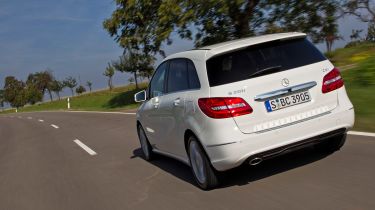Mercedes B200 Sport
Our verdict on the 1.6-litre petrol powered version of the new Mercedes B-Class

For a car that offers so much new technology, the B-Class is surprisingly bland to drive - that’s not to say it won’t be a huge success though. The roomy, top-quality interior will be enough to sway most customers, while the fact that BMW and Audi don’t build direct rivals also plays in its favour. The turbocharged petrol engine is smooth and punchy when revved, but ultimately it’s the more economical diesels that make most sense. If you can stretch to it, we’d spend £1,450 on the super-smooth dual-clutch automatic gearbox, too. The B-Class is a stylish, competent car, but not the game-changer we’d all hoped for.
The new B-Class is the most significantly changed model Mercedes has ever introduced. It features new manual and dual-clutch gearboxes, an all-new front-wheel drive chassis and a host of advanced safety systems. There’s a new range of engines too – last week we tried the 1.8-litre diesel, but now it’s the turn of the 1.6-litre direct-injection turbocharged petrol model.
Video: watch our video review of the Mercedes B-Class
[[{"type":"media","view_mode":"content_narrow","fid":"68782","attributes":{"alt":"","class":"media-image"}}]]
The range-topping 134bhp 1.8-litre diesel engine in the B200CDI impressed us with its power and refinement, but the 154bhp in the B200 has a different character altogether.
Used - available now

2022 Mercedes
B Class
24,802 milesAutomaticPetrol1.3L
Cash £20,263
2023 Mercedes
B Class
37,669 milesAutomaticDiesel2.0L
Cash £18,990
2021 Mercedes
B Class
55,761 milesAutomaticPetrol1.3L
Cash £16,163
2023 Mercedes
B Class
31,683 milesAutomaticPetrol1.3L
Cash £18,887Despite maximum torque of 250Nm arriving at 1,250rpm, it’s easy to catch the turbo off boost. The trick is to let the engine rev higher, then there’s plenty of power for overtaking and maintaining your speed on a motorway.
With its lower centre of gravity and new four-link rear suspension setup, the handling should be superb but it’s far from perfect. The variable ratio steering reacts quickly to your inputs and the car stays flat in the bends, which should deliver a sporty feel, but instead it never feels light on its feet, and is far happier gently cruising along. By comparison, its main rival the Ford C-MAX is more agile when you up the pace.
Our ‘Sport’ test car was fitted with lowered sports suspension, 18-inch alloys and run flat tyres – all of which made the ride feel fidgety over uneven surfaces. On smooth tarmac the car flowed well from corner to corner, but this type of road is rare in the UK. On this evidence we’d opt for the smaller wheels and standard suspension.
The roofline is 5cm lower than its predecessor and it’s wider too – immediately giving it a sportier appearance. The now familiar two-bar grille dominates the front end, while the profile is characterised by just two simple converging creases.
Its sleek looks serve a purpose too – it’s the world’s most aerodynamically efficient production car, an accolade shared with the E-Class Coupe.
Order the essential £600 Easy Vario Package, which adds a folding front passenger seat and a sliding rear bench, and the interior is hugely versatile. The boot floor can be raised to make a flat loading area and there’s 666-litres of space with the rear seats moved forward.
Quality has taken a huge leap too, helped by the SLS-inspired solid-metal air vents and the iPad-style central screen. If you consider the badge conscious buyers who will be looking at the B-Class, it’s the high-class cabin that will appeal the most.







